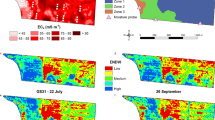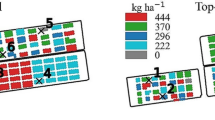Abstract
To improve irrigation efficiency, it is important to optimize agriculture irrigation scheduling. The objectives of this study were to evaluate the AquaCrop model for its ability to simulate cotton in the North China Plain and optimize irrigation strategies. The AquaCrop model was calibrated using 2002–2009 data and validated using 2010–2014 data. Root mean square error (RMSE), mean absolute error (MAE) and residual coefficient method (CRM) were used to test the model performance. The model calibrated for simulating cotton yield had a prediction error statistic RMSE of 0.152 t hm−2, MAE of 0.123 t hm−2 and CRM of 0.120. On validation, the RMSE was 0.147 t hm−2, MAE was 0.094 t hm−2 and CRM was 0.092. The goodness-of-fit values for the calibration and validation data sets indicated that the model could be used to simulate cotton yield. The analysis of irrigation scenarios indicated that the highest irrigation water productivity could be obtained by applying one irrigation at the seedling stage in a wet year, two irrigations, at the seedling and squaring stages, in a normal year and three irrigations, at the seedling, squaring and flowering stages, in a dry year. These results could be useful to the government in determining reasonable, well-timed irrigation for agricultural regions.




Similar content being viewed by others
References
Ali MH, Talukder MSU (2008) Increasing water productivity in crop production--a synthesis. Agric Water Manag 95(11):1201–1213
Abedinpour M, Sarangi A, Rajput TBS, Singh M, Pathak H, Ahmad T (2012) Performance evaluation of AquaCrop model for maize crop in a semi-arid environment. Agric Water Manag 110(3):55–66
Akhtar F, Tischbein B, Awan UK (2013) Optimizing deficit irrigation scheduling under shallow groundwater conditions in lower reaches of Amu Darya River basin. Water Resour Manag 27:3165–3178
Ahmadi SH, Mosallaeepour E, Kamgar-Haghighi AA, Sepaskhah AR (2015) Modeling maize yield and soil water content with aquacrop under full and deficit irrigation managements. Water Resour Manag 29(8):1–17
Bird DN, Benabdallah S, Gouda N, Hummel F, Koeberl J, Jeunesse IL, Meyer S, Prettenthaler F, Soddu A, Susanne WG (2016) Modelling climate change impacts on and adaptation strategies for agriculture in Sardinia and Tunisia using AquaCrop and value-at-risk. Sci Total Environ 543:1019–1027
Chen YM, Guo GS (1995) Main crop water demand and irrigation in China. China Water & Power Press, Beijing
Chen D, Ye G, Yang C, Chen Y, Wu Y (2012) The effect of high temperature on the insecticidal properties of Bt Cotton. Cotton Science 53(3):333–342
Diepen CV, Wolf J, Keulen HV, Rappoldt C (2007) WOFOST: a simulation model of crop production. Soil Use Manag 5(1):16–24
Farahani HJ, Izzi G, Oweis TY (2009) Parameterization and evaluation of the AquaCrop model for full and deficit irrigated cotton. Agron J 101(3):469–476
Geerts S, Raes D, Garcia M, Taboada C, Miranda R, Cusicanqui J (2009) Modeling the potential for closing quinoa yield gaps under varying water availability in the Bolivian Altiplano. Agric Water Manag 96(11):1652–1658
García-Vila M, Fereres E (2012) Combining the simulation crop model aquacrop with an economic model for the optimization of irrigation management at farm level. Eur J Agron 36(1):21–31
Hsiao TC, Heng L, Steduto R-LB, Raes D, Fereres E (2009) AquaCrop-the FAO crop model to simulate yield response to water: III. Parameterization and testing for maize. Agron J 101(3):448–459
Jones JW, Hoogenboom G, Porter CH, Boote KJ, Batchelor WD, Hunt LA (2003) Dssat cropping system model. Eur J Agron 18(3):235–265
Kisekka I, Aguilar JP, Rogers DH, Holman J, Brien DM, Klocke N (2016) Assessing deficit irrigation strategies for corn using simulation. Transactions of the Asae American Society of Agricultural Engineers 59(1):303–317
Li BB, Lu JH, Wu JD (1995) A primary study on the effects of drought and waterlogging on cotton production in Jiangsu province I Effect of drought and watterlogging on cotton growing. Chin J Agrometeorol 16(3):23–26
Liu J, Wiberg D, Zehnder AJB, Yang H (2007) Modeling the role of irrigation in winter wheat yield, crop water productivity, and production in China. Irrig Sci 26(1):21–33
Li H, Liu Y, Cai JB, Mao XM (2011) The applicability and application of AquaCrop model. J Irrig Drain 30(3):28–32
Linker R, Sylaios G (2016) Efficient model-based sub-optimal irrigation scheduling using imperfect weather forecasts. Comput Electron Agric 130:118–127
Montoya F, Camargo D, Ortega JF, Córcoles JI, Domínguez A, Clothier BE (2016) Evaluation of Aquacrop model for a potato crop under different irrigation conditions. Agric Water Manag 164:267–280
Malik A, Shakir AS, Ajmal M, Khan MJ, Khan TA (2017) Assessment of AquaCrop Model in Simulating Sugar Beet Canopy Cover, Biomass and Root Yield under Different Irrigation and Field Management Practices in Semi-Arid Regions of Pakistan. Water Resour Manag 4:1–18
Prieto D, Angueira C, Kirda C, Moutonnet P, Hera C, Nielsen DR (1996). Water stress effect on different growing stages for cotton and its influence on yield reduction. Crop Yield Response to Deficit Irrigation Dordrecht, Kluwer Academic Publishers, The Netherlands
Raes D, Steduto P, Hsiao TC, Fereres E (2009) AquaCrop-The FAO crop model to simulate yield response to water II: Main algorithms and software description. Agron J 101(3):438–447
Raes D, Steduto P, Hsiao TC, Fereres E (2012) Crop Water Productivity. In: Calculation Procedures and Calibration Guidance. AquaCrop version 4.0. FAO, Land and Water Development Division, Rome
Stockle CO, Donatelli M, Nelson R (2003) CropSyst a cropping systems simulation model. Eur J Agron 18:289–307
Steduto P, Hsiao TC, Raes D, Fereres E (2009) Aquacrop- the FAO crop model to simulate yield response to water I: concepts and underlying principles. Agron J 101(3):448–459
Salemi H, Soom MAM, Mousavi SF, Ganji A, Lee TS, Yusoff MK (2011) Irrigated silage maize yield and water productivity response to deficit irrigation in an arid region. Pol J Environ Stud 20(5):1295–1303
Silvestro PC, Pignatti S, Yang H, Yang G, Pascucci S, Castaldi F (2017) Sensitivity analysis of the Aquacrop and SAFYE crop models for the assessment of water limited winter wheat yield in regional scale applications. PLoS One 12(11):e0187485
Singh K, Gupta N, Dhingra M (2018) Effect of temperature regimes, seed priming and priming duration on germination and seedling growth on American cotton. J Environ Biol 39(1):83–91
Tsakmakis ID,Kokkos N, Pisinaras V, Papaevangelou V, Hatzigiannakis E, Arampatzis G, Gikas GD, Linker R, Zoras S, Evagelopoulos V, Tsihrintzis VA, Battilani A, Sylaios G (2016). Operational precise irrigation for cotton cultivation through the coupling of meteorological and crop growth models. Water Resources Management 31(1):1–18
Tsakmakis ID, Zoidou M, Gikas GD, Sylaios GK (2018) Impact of Irrigation Technologies and Strategies on Cotton Water Footprint Using AquaCrop and CROPWAT Models. Environmental Processes 8:1–19
Voloudakis D, Karamanos A, Economou G, Kalivas D, Vahamidis P, Kotoulas V, Kapsomenakis J, Zerefos C (2015) Prediction of climate change impacts on cotton yields in greece under eight climatic models using the aquacrop crop simulation model and discriminant function analysis. Agric Water Manag 147:116–128
Yang HS, Dobermann A, Lindquist JL, Walters DT, Arkebauer TJ, Cassman KG (2004) Hybrid-maize—a maize simulation model that combines two crop modeling approaches. Field Crop Res 87:131–154
Yue JJ, Sun JS, Xu JX, Deng F (2012) Effect of Water Deficit on the Growth and Water Production Benefit of Cotton in Planting Pattern of Cotton Intercropping with Melon. J Irrig Drain 31(5):35–39
Acknowledgements
The authors would like to acknowledge the financial support for this work provided by the National Key Research and Development Program of China (Grant No.2016YFC0401407), and the National Natural Science Foundation of China (Grant No.51579169).
Author information
Authors and Affiliations
Corresponding author
Ethics declarations
Conflict of Interest
The authors declared that they have no financial conflicts of interest with respect to this study.
Rights and permissions
About this article
Cite this article
Li, F., Yu, D. & Zhao, Y. Irrigation Scheduling Optimization for Cotton Based on the AquaCrop Model. Water Resour Manage 33, 39–55 (2019). https://doi.org/10.1007/s11269-018-2087-1
Received:
Accepted:
Published:
Issue Date:
DOI: https://doi.org/10.1007/s11269-018-2087-1




